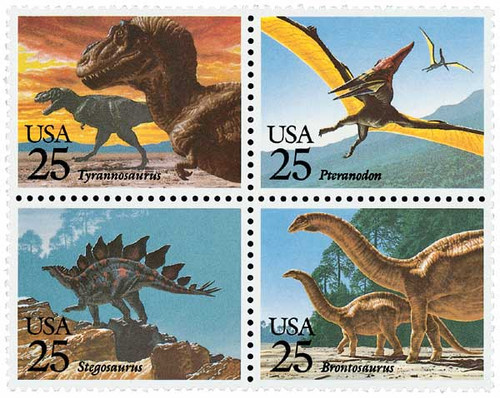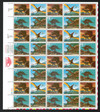
# 2422-25 - 1989 25c Prehistoric Animals
U.S. #2422-25
1989 25¢ Prehistoric Animals
Block of 4
- Block of four pictures prehistoric animals that once lived in the western US
- Issued for National Stamp Collecting Month
Stamp Category: Commemorative
Value: 25¢, first-class rate
First Day of Issue: October 1, 1989
First Day City: Lake Buena Vista, Florida
Quantity Issued: 101,747,000 blocks
Printed by: Bureau of Engraving and Printing
Printing Method: Lithographed and engraved
Format: Panes of 40 in sheets of 160
Perforations: 11
Why the stamps were issued: To promote National Stamp Collecting Month. In fact, the campaign behind these stamps was one of the largest up to that point. The USPS worked with MCA Home Video to include a flyer for the stamps in the video cassette packaging for the dinosaur-themed movie The Land Before Time. It was covered in the media, on the front page of USA Today, and in TV commercials. Many of these materials promoted that year’s slogan, “Begin an Adventure of Giant Proportions – Collect Stamps.”
About the stamp designs: The USPS hired John Gurche, who specializes in painting prehistoric animals, to illustrate these stamps. Prior to the stamps, he’d painted the creatures for books and magazines as well as murals for the National Museum of Natural History and the Smithsonian Institution. In fact, he used the Smithsonian as one of his main resources in researching the creatures. Gurche made repeated visits to the fossilized bones to get his images just right. Before beginning his paintings, he also made clay models of each creature.
Gurche had hoped to illustrate some more exotic creatures, but the USPS had already made its choices. With that in mind, he knew he wanted to present the dinosaurs in new ways. “Some of these ideas had to do with body positions, posture and locomotion, I painted them basically in more active poses, which goes along with the current idea that some dinosaurs perhaps were warm-blooded,” he said.
The predatory tyrannosaurus rex (#2522) is seen running while hunting for his daily meal.
The winged Pteranodons (#2423) soar high overhead, flapping their wings in flight.
The stegosaurus (#2424) is ambling up a landscape as rough and uneven as his armor-plating.
The gentle vegetarian brontosaurus (#2425), meaning thunder lizard, was named for its gigantic size. The stamp pictures a brontosaurus with a juvenile.
All but the stegosaurus stamp pictures two creatures, displaying how they were social creatures. Gurche also used the background colors for dramatic effect, most notably on the tyrannosaurus stamp. The red-orange sky gave it “sort of an evil, menacing feel.”
First Day City: The First Day ceremony for these stamps was held at the Universe of Energy Exhibit in Epcot Center at Disney World, in Orlando, Florida.
Unusual fact about these stamps: Blocks of the Prehistoric Animals stamps have been found with the black engraving missing. The black engraving includes “USA,” the denomination, and each creature’s name.
About the Prehistoric Animals Block: The set is often referred to as “dinosaur stamps,” however one of the creatures, the winged Pteranodon, isn’t a dinosaur. Early plans for the stamps included a wider variety of creatures including the ancestor of the horse, a woolly mammoth, a flying reptile, and a saber-tooth tiger. The topical subcommittee found the subjects unbalanced and decided that the idea of primitive beasts was too general. So they decided that the creatures should all come from the Age of Reptiles. They put together a list of five creatures – the four that made it onto the stamps, plus the triceratops. They included the triceratops in case their consultants through the Pteranodon didn’t belong. But they found it helped bring variety compared to the large creatures on the other stamps.
The sheet’s selvage includes a red “Stampasaurus” with stamp-shaped spikes running down its spine. This mascot was also included in several pictorial cancelations throughout the summer and fall leading up to the stamps’ issue, as well as during National Stamp Collecting Month.
About National Stamp Collecting Month stamps: October has been designated by the US Postal Service as National Stamp Collecting Month. The first celebration occurred in 1981 as a way to promote the hobby of collecting stamps. Each year, new stamps are issued in early October to stimulate additional interest, and many philatelic organizations hold special programs during the month.
History these stamps represent: Dinosaurs ruled the earth during the Mesozoic Era, a period that began about 240 million years ago. Although some were as small as chickens, other species were among the largest animals to ever inhabit Earth. Some were plant eaters while others were carnivores. Scientists divide dinosaurs into two major groups – Ornithischians with birdlike hip structures and Saurischians, which feature a hip structure like that of a lizard. For reasons that aren’t fully understood, dinosaurs became extinct about 63 million years ago.
U.S. #2422-25
1989 25¢ Prehistoric Animals
Block of 4
- Block of four pictures prehistoric animals that once lived in the western US
- Issued for National Stamp Collecting Month
Stamp Category: Commemorative
Value: 25¢, first-class rate
First Day of Issue: October 1, 1989
First Day City: Lake Buena Vista, Florida
Quantity Issued: 101,747,000 blocks
Printed by: Bureau of Engraving and Printing
Printing Method: Lithographed and engraved
Format: Panes of 40 in sheets of 160
Perforations: 11
Why the stamps were issued: To promote National Stamp Collecting Month. In fact, the campaign behind these stamps was one of the largest up to that point. The USPS worked with MCA Home Video to include a flyer for the stamps in the video cassette packaging for the dinosaur-themed movie The Land Before Time. It was covered in the media, on the front page of USA Today, and in TV commercials. Many of these materials promoted that year’s slogan, “Begin an Adventure of Giant Proportions – Collect Stamps.”
About the stamp designs: The USPS hired John Gurche, who specializes in painting prehistoric animals, to illustrate these stamps. Prior to the stamps, he’d painted the creatures for books and magazines as well as murals for the National Museum of Natural History and the Smithsonian Institution. In fact, he used the Smithsonian as one of his main resources in researching the creatures. Gurche made repeated visits to the fossilized bones to get his images just right. Before beginning his paintings, he also made clay models of each creature.
Gurche had hoped to illustrate some more exotic creatures, but the USPS had already made its choices. With that in mind, he knew he wanted to present the dinosaurs in new ways. “Some of these ideas had to do with body positions, posture and locomotion, I painted them basically in more active poses, which goes along with the current idea that some dinosaurs perhaps were warm-blooded,” he said.
The predatory tyrannosaurus rex (#2522) is seen running while hunting for his daily meal.
The winged Pteranodons (#2423) soar high overhead, flapping their wings in flight.
The stegosaurus (#2424) is ambling up a landscape as rough and uneven as his armor-plating.
The gentle vegetarian brontosaurus (#2425), meaning thunder lizard, was named for its gigantic size. The stamp pictures a brontosaurus with a juvenile.
All but the stegosaurus stamp pictures two creatures, displaying how they were social creatures. Gurche also used the background colors for dramatic effect, most notably on the tyrannosaurus stamp. The red-orange sky gave it “sort of an evil, menacing feel.”
First Day City: The First Day ceremony for these stamps was held at the Universe of Energy Exhibit in Epcot Center at Disney World, in Orlando, Florida.
Unusual fact about these stamps: Blocks of the Prehistoric Animals stamps have been found with the black engraving missing. The black engraving includes “USA,” the denomination, and each creature’s name.
About the Prehistoric Animals Block: The set is often referred to as “dinosaur stamps,” however one of the creatures, the winged Pteranodon, isn’t a dinosaur. Early plans for the stamps included a wider variety of creatures including the ancestor of the horse, a woolly mammoth, a flying reptile, and a saber-tooth tiger. The topical subcommittee found the subjects unbalanced and decided that the idea of primitive beasts was too general. So they decided that the creatures should all come from the Age of Reptiles. They put together a list of five creatures – the four that made it onto the stamps, plus the triceratops. They included the triceratops in case their consultants through the Pteranodon didn’t belong. But they found it helped bring variety compared to the large creatures on the other stamps.
The sheet’s selvage includes a red “Stampasaurus” with stamp-shaped spikes running down its spine. This mascot was also included in several pictorial cancelations throughout the summer and fall leading up to the stamps’ issue, as well as during National Stamp Collecting Month.
About National Stamp Collecting Month stamps: October has been designated by the US Postal Service as National Stamp Collecting Month. The first celebration occurred in 1981 as a way to promote the hobby of collecting stamps. Each year, new stamps are issued in early October to stimulate additional interest, and many philatelic organizations hold special programs during the month.
History these stamps represent: Dinosaurs ruled the earth during the Mesozoic Era, a period that began about 240 million years ago. Although some were as small as chickens, other species were among the largest animals to ever inhabit Earth. Some were plant eaters while others were carnivores. Scientists divide dinosaurs into two major groups – Ornithischians with birdlike hip structures and Saurischians, which feature a hip structure like that of a lizard. For reasons that aren’t fully understood, dinosaurs became extinct about 63 million years ago.













